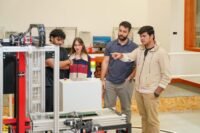Max Hsu, Regional Director MEA, ViewSonic, shares tips on how teachers can do more in less time with the help of technology and a dash of creativity
Besides being a rewarding job, teaching comes with a lot of responsibilities. A big pile of paperwork and impending deadlines are day-to-day struggles that a teacher goes through. Following the pandemic, their jobs got harder, with remote learning, longer work hours and repeated changes from remote to hybrid to in-person learning. Teachers are expected to make learning exciting, tackle students’ emotional needs, grade students’ work efficiently, analyze data and much more. The rising expectations have had a huge impact on the health and well-being of teachers. The 2021 State of the US Teacher Survey found that the proportion of K-12 educators seriously worried about burnout rose from one quarter to 57 percent.
In this scenario, it would be highly unfair to expect teachers to work effectively.
However, with some creative planning, support from the school authorities and the right EdTech tools, teacher workload can be managed. Let’s start with what school authorities can do to help with it.
To start with, schools should provide an agreed directed time calendar to discharge their duties. This should include everything from lesson planning and preparation to assessment, monitoring, recording and reporting on the progress of assigned students. This way teachers would get the right time frame to discharge their duties.
The school administration can create support groups for teachers. These groups will help teachers to speak about issues affecting them, share problems and find solutions.
Supporting teachers with the right technology is another sureshot way in which the schools can help. The right EdTech solutions could do wonders in creating a seamless process to manage their day-to-day tasks such as preparation, sharing feedback and getting students to participate effectively.
Preparation
Preparation takes a significant amount of time, especially for new teachers. Right preparation can save a lot of time but if you know the correct way to do it. It shouldn’t be about producing lengthy documents but to evaluate, adapt and improve lessons, as well as logging how far a class is through the syllabus.
Some effective tools such as digital whiteboards are ideal for teachers to prepare lessons as they can quickly and easily add content and set up complete lessons. A good example would be the ViewSonic Whiteboard. It includes built-in teaching materials with readymade templates and supportive content that teachers can access anytime, anywhere. The Whiteboard can enhance the lessons with audiovisual elements such as diagrams, photos and videos, while Originals can help with materials and learning activities that are engaging and aligned with student needs.
Participation
Having eye-catching assets can elevate the classroom experience from passive observation to active engagement. Videos, pictures, 3D drawings and diagrams can enhance learning outcomes while making the whole experience more fun for students. Originals features an extensive stock collection for teachers to add safe, copyright-cleared media to their lessons.
Feedback
While reports can be extremely helpful in sharing feedback, it adds to teachers’ workload. By integrating the right solution, schools can help teachers to develop detailed reports in lesser time.
Tools such as Sens can be helpful for teachers to extract data about students’ emotional states and engagement during the lesson. Driven by advanced machine learning, it collects environmental and engagement metrics to optimise use of the best possible learning outcomes one classroom at a time. Teachers can have much-needed information on a student’s progress, attendance and punctuality instantly, making communication with staff and parents simple and effective.
While schools can help, it is also up to the teachers to help themselves. With some creative planning, open communication and use of the right technology, they should be able to manage workload to a large extent.
- Choose effective learning methods – It is important that a teacher knows the best learning methods in order to deliver quality learning outcomes with minimum effort. The choice of learning methods depends on what fits the requirement based on the subject area, classroom demography, and the expected outcome from students. However, if teachers are aware of emerging trends and models, they can practice it, or even adapt new frameworks to reduce their workload.
- Delegate when needed – Teachers should delegate smaller tasks to students. It will give a sense of ownership to them, while freeing up teachers’ attention to more important things.
- Communicate with administration – Teachers should never hesitate to communicate with the administration if they feel overburdened. Only if the administration is aware of the aid they need to provide will they be able to provide timely assistance.
- Create a schedule for school and home – It’s always good to have a schedule with proper tasks listed in a calendar along with respective time estimates for both school and home. This way it would be easier to manage the workload and also have a work-life balance.
- Use technology to your rescue – Nothing would be more handy than an advanced yet easy technology tool that can allow teachers to perform tasks quickly and efficiently. Automate grading, use digital whiteboards, set notifications – experiment with tech to use it to your advantage.
- Say no when you need to – It’s as simple as it reads. Set clear boundaries for your time even if it means you have to say no at times.








